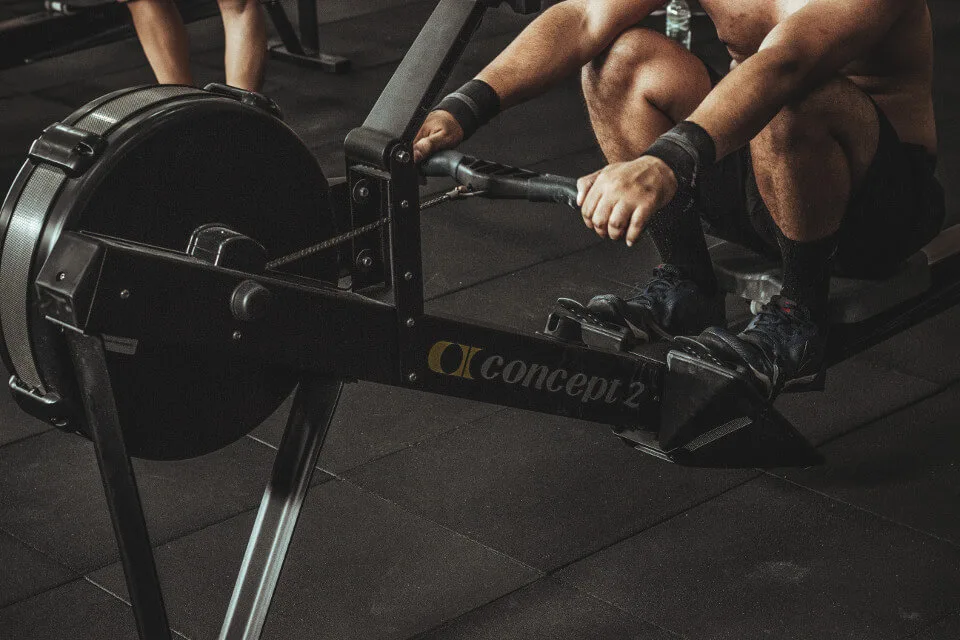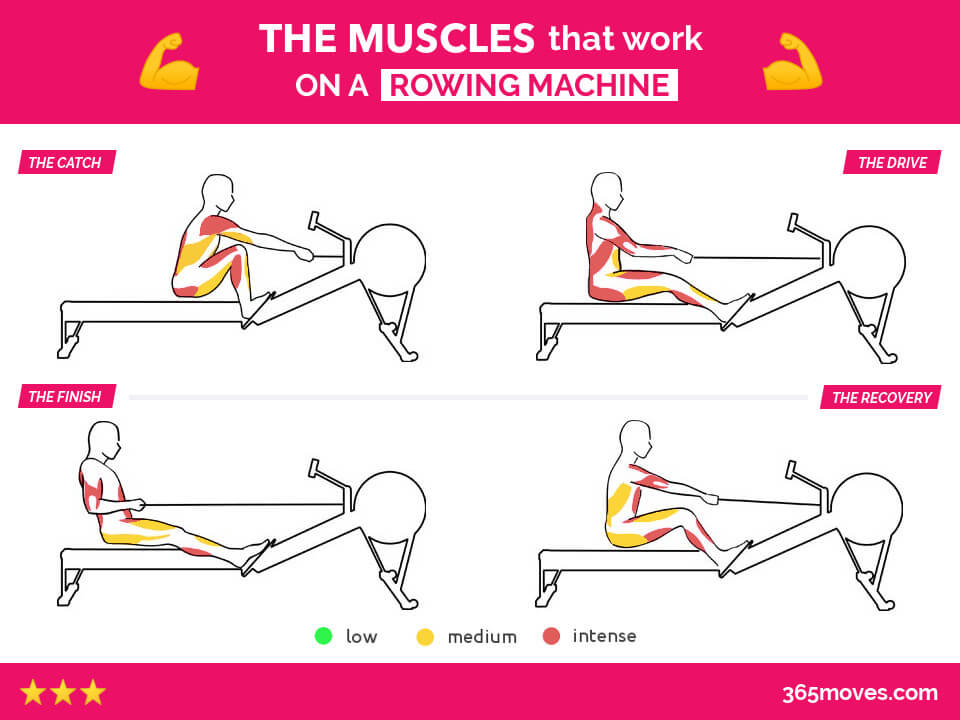What Muscles does a Rowing Machine Work?

The rowing machine offers a great cardio workout that can be quite demanding! The higher the resistance, the more demanding and the better for the muscles though. Especially when the resistance is set at a high level, it can have great benefits on your arms, calves and leg muscles, thighs and buttocks, but also on your abs and breast muscles. In addition, rowing helps you lose calories and fat. It is a great workout if you want to lose weight, strengthen your muscles, tone your arms and legs and get a lean body.
We'll explain you what muscles work on a rowing machine and which workout routines are more effective to build muscle and burn calories.
1. What muscles does the rowing machine target?
First and foremost, rowing works out the most important of all muscles, namely your heart!
Working out on a rowing machine also has many health benefits, increases your endurance and stamina, and is an ideal sport to lose weight. The rowing machine, or the rower, can help you build muscle and target specific parts of your body, which is essential if you want to refine your body.
The advantage with the rowing machine (compared to outdoor rower) is that you can choose how hard you want to work your muscles. The more you increase the resistance of your machine, the more you work your muscles and develop your muscle mass.

The muscles that work on a rowing machine for each position
Besides the heart, the muscles targeted by the rowing machine are the arm, leg and thigh muscles as well as the buttocks (or glutes) but also the abdominals and back muscles. Rowing is a coordinated action that involves a very large number of muscles.
The muscles in the upper part of the body
- The biceps and triceps, muscles from the front and back of the arms. At the drive and at the finish, the biceps work to pull the handle, whereas your triceps work at the catch to extend your arms and at the recovery to push the arms forward.
- The abdominal muscles or abs stabilize the body at the finish and flex the torso forward at the recovery.
- The back muscles work more at the drive and the finish.
- The shoulder muscles are contracting at the drive.
The muscles in the lower part of the body
- The quadriceps or quads and the hamstrings, muscles of the front and the back of the thigh, are alternately working while you are rowing, especially at the catch and drive for the quadriceps and at the recovery for the hamstrings.
- The gluteal muscles or glutes (large, medium and small buttocks) are also working out when you are exercising, to a higher extent at the catch and the drive.
- The calf muscles, called triceps sural, located at the back of the leg, are almost constantly working.
Make sure you have a good position on your rowing machine to prevent any injury, muscle or back pain.
WHAT YOU SHOULD KNOW: Your muscles need resistance to work! The more you increase the resistance of your rowing machine, the more strength you need to provide and the more your muscles work. On the contrary, if the resistance is too low, you will hardly increase your muscle mass and it will be more like a cardio training.
2. How long does it take to build muscle on the rowing machine?
One thing is sure: It will not happen overnight and certainly not without effort! In order to get the perfect body with firm thighs and perfect buttocks, you need to be constant and workout regularly. You'll see the results after a few weeks. Be patient and persistent and you will see the effect of the rowing machine on your body. If you want to track the evolution of your muscle mass, you can do it with a body fat scale.
In general, you should start seeing the first effects after a few weeks:
- After 4 to 6 weeks, your legs, thighs and buttocks are more firm. Your workout also feels easier and less demanding than at the very beginning.
- After 6 weeks, it feels easier and your body has get used to it. Continue working out at this pace and eventually increase the duration and intensity of your exercises, not too much though because doing too much could have a negative impact on your motivation.
- After 2 to 3 months, you should clearly see the change. Your legs, your thighs and your buttocks are much more muscular than when you started exercising. Your muscle mass has increased and your fat mass decreased so that your body shape has become more athletic.
Does the rowing machine make your legs and thighs bigger? Don't worry: rowing regularly will not make your legs or your thighs fatter! The rowing machine is demanding but it's not a strength machine with heavy weights! It offers a cardio workout (cardio training) that will tone and refine your legs, thighs and buttocks. If you want to increase the volume of your muscles, then you will have to combine regular training on a rowing machine or a rower for 1 hour every day or even more at a very high resistance level combined with weight training to build muscle. Moreover, the results will come slowly, little by little... so you must persevere!
3. Rowing machine workout routines to strengthen and build muscle
It all depends on your goal: do you rather want to lose weight (and fat) and tone your muscles or really gain muscle mass and volume?
1. To tone and strengthen your buttocks, thighs and legs muscles, you can for instance do a HIIT training on your rowing machine for 20 to 30 minutes 2 times a week, alternating between high intensity phases and recovery phases. Increase the resistance of your rowing machine during the high intensity phases in order to make your muscles work. You should alternate HIIT with cardio workouts of 30 to 45 minutes or more once or twice a week in order to burn fat (aerobic exercise). You will combine fat and weight loss during cardio workout with muscle growth during HIIT training.
2. To muscle your thighs and legs, you can focus almost exclusively on HIIT training with high increases in the resistance of the rowing machine. For example, you can do 3 to 5 HIIT workouts per week for 15 to 30 minutes.
Here are two rowing machine training plans for gaining muscle and losing weight (N ° 1) and for a greater muscle growth (N ° 2):
1. Training Plan - Beginner
• Combined Cardio & HIIT Workout on Monday (20 to 30 min)
• Cardio Workout at a medium intensity on Thursday (30 to 45 min)
• HIIT Training every Saturday (15-20 min)
2. Training Plan - Advanced
• HIIT Workout on Monday and Wednesday (20 to 30 min)
• Cardio Workout on Thursday (45 min to 1 hour)
• HIIT Training on Saturday (20 to 30 min)
The rowing machine or the rower is the perfect sports to tone and strengthen legs, thighs and buttocks but also to work the arms, abs and back muscles.
Always start your training session with a warm-up at moderate intensity for 5 to 10 minutes and gradually increase the resistance of your rowing machine. The higher the resistance, the more your muscles work. It takes (a little) time to get results, gain muscle and get rid of fat. Perseverance is the key to success ;)

David Anderson
Fitness Writer
David Anderson is a professional coach with 15 years of experience in the sports and fitness industry. He has been writing about fitness and giving workout tips and advice since 2016.
